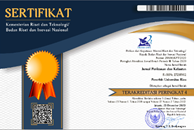The Relationship of Population's Knowledge, Attitudes, and Communication with Population's Participation in the Mangrove Rehabilitation Program in Pulau Cawan Village, Mandah District, Indragiri Hilir District, Riau Province
(1) Department of Fisheries Socio-Economic, Faculty of Fisheries and Marine, Universitas Riau
(2) Department of Fisheries Socio-Economic, Faculty of Fisheries and Marine, Universitas Riau
(3) Department of Fisheries Socio-Economic, Faculty of Fisheries and Marine, Universitas Riau
(*) Corresponding Author
Abstract
Keywords
Full Text:
PDFReferences
Adioetomo, A., Moertaningsih, S., Bulan, S.O. (2010). Dasar-dasar demografi. Salemba Empat. Jakarta.
Arikunto, S. (2019). Prosedur penelitian suatu pendekatan praktik. Jakarta. Rineka Cipta.
Gerald, T.E. (2016). Sikap dan perilaku masyarakat dalam pengelolaan ekosistem mangrove di Kecamatan Teluk Ambon. Jurnal Triton, 12(1): 1-9.
Herman, H. (2019). Tingkat partisipasi masyarakat dalam
perencanaan pembangunan Desa Ulidang Kecamatan Tammerodo Kabupaten Majene. Jurnal Ilmiah Ekonomi Pembangunan, 1(1): 75-98.
Kalen, D.S. (2016). Pendekatan kuantitatif dan kualitatif dalam penelitian ilmu sosial. Studi Philosophica et Theologica, 16(2): 197-210.
Kriyanto, K., Rahmat, R. (2006). Teknis praktis riset komunikasi disertasi contoh praktis riset media, public relation, advertising, komunikasi organisasi, komunikasi pemasaran. Kencana Prenamedia Group. Jakarta.
Kuncoro, M. (2013). Mudah memahami dan menganalisis indikator ekonomi. UPP STIM YKPN. Jakarta.
Naomi, C.D., Erwiantono, E., Wahyuni, A.A. (2023). Strategi komunikasi lingkungan mangrove center community dalam meningkatkan partisipasi masyarakat pada kegiatan ekowisata di Kampung Tembu dan Kabupaten Berau. Journal Ilmu Komunikasi, 10(3): 69-81.
Nuruliah, K.R. (2015). Lingkungan sosial dalam perkembangan psikologis anak. Jurnal Ilmu Komunikasi, 2(1): 32-38.
Oktavia, F. (2016). Upaya komunikasi interpersonal kepala desa dalam memediasi kepentingan PT. Bukit Borneo Sejahtera dengan masyarakat Desa Long Lunuk. Jurnal Ilmu Komunikasi, 4(1): 239-253.
Purnama, F.S., Putriningtias, A., Muhammad, F.T. (2017). Kondisi vegetasi hutan mangrove Kuala Langsa Kota Langsa – Aceh. Jurnal Ilmiah Samudra Akuatika, 1(1).
Rahmad, Y., Elfrida, E., Mawardi, M., Mubarak, A. (2020). Keanekaragaman tumbuhan mangrove di Desa Alur Dua tahun 2019. Jurnal Jeumpa, 7(1): 341-348.
Retnawati, H. (2017). Teknik pengambilan sampel. Yogyakarta.
Ritohardoyo, S., Bayu, A.G. (2014). Arahan kebijakan pengelolaan hutan mangrove: Kasus Pesisir Kecamatan Teluk Pakedai, Kabupaten Kuburaya, Provinsi Kalimantan Barat. Jurnal Geografi, 11(1): 43-57.
Sugiyono, S. (2019). Metode penelitian kualitatif, kuantitatif, dan R&D. Alfabeta CV. Bandung.
Sulistyowati, L., Fauzi, H.M., Lopa, G.A., Darwiyati, D. (2021). Partisipasi masyarakat dalam pengelolaan hutan mangrove untuk meningkatkan ekonomi di Desa Tambakrejo Kabupaten Malang Jawa Timur. Scientific Journal of Reflection, 4(4): 741-749.
Suparmoko, M. (2000). Pengantar ekonomika makro. BPFE. Yogyakarta.
Widjarjono, W. (2010). Analisis statistika multivariat terapan. UPP STIM YKPN. Yogyakarta.
Article Metrics
Abstract view : 21 timesPDF - 8 times
DOI: http://dx.doi.org/10.31258/jpk.29.2.197-203
Copyright (c) 2024 Rizki Ramadhan, Zulkarnain Zulkarnain, Firman Nugroho

This work is licensed under a Creative Commons Attribution-NonCommercial-NoDerivatives 4.0 International License.
Gedung Marine Center Lt 2. Fakultas Perikanan dan Kelautan Universitas Riau



